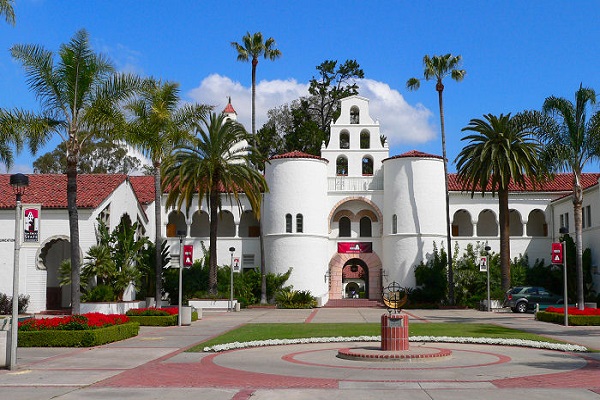San Diego State University: Finding The Toxic ‘Needle In a Haystack’
Dr. Eunha Hoh is a treasure-hunting scientist. But she’s not looking for gold. Instead, she pans for extremely rare and nearly invisible toxic chemicals–the forgotten leftovers from everyday items.
By Peggy Pico
Story Keywords: Research
Print Page
Email
The article first published in the 2022 edition of Highlights: A Magazine of Research, Scholarship and Creative Activities at SDSU.
The eternal afterlife of tiny trash.
It’s not something most young girls think about. But Eunah Hoh did.
“I always knew I’d be a scientist,” said the San Diego State University public health researcher. “I was good at math and I loved reading books about invisible things.”
Many kids long for superpowers to uncover hidden secrets. But as a child, Hoh experienced the real magic of discovery from her dad — a research and development scientist for the South Korean defense department.
“When my dad returned from his many work trips to the U.S., he brought me encyclopedias and books from NASA and science museums,” she said, “I devoured them, and my fascination for invisible molecules and mysteries grew stronger.”
Hoh’s dad encouraged her scientific curiosity, advising her to pursue chemistry in college. She complied, won over by his insistence that chemistry contains the basic, and often invisible, building blocks of life.
Armed with a master’s in chemistry from the Korea Advanced Institute of Science and Technology, Hoh landed a job at a major electronics manufacturer. A few years later, she visited the company’s production facility and came face-to-face with a grim reality: “I was shocked to see hundreds of liters of toxic chemicals and solvents pouring from the enormous wastewater pipeline.”
The discovery reignited Hoh’s childhood pursuit and launched her quest to expose hidden and invisible toxic chemicals. Now, she and her extensive transdisciplinary research teams scour oceans, freshwater, air, farms, houses and roads to “find rarely tested pollutants and novel contaminants previously unknown and to better understand how they impact humans, wildlife, and our environment,” said Hoh.
Through a novel approach of molecular-level analysis, she and her team discovered chemical pollutants, often from everyday items like cloth microfibers and tire dust — the microscopic debris deposited on freeways and streets by millions of cars.
“The friction between tires and the road leaves tiny particles that are blown or washed away into nearby water,” said Hoh. “With so many cars on the road, I want to know what that is doing to our environment, fish, air and health–and our findings could lead to more environmentally friendly formulated tire products.”
To uncover the unknown, Hoh designed a non-targeted technique for luring toxic organic chemicals out of hiding. Instead of using a standard method to search for known toxins like DDT, she developed new instruments that identify all the chemicals in a given sample, known or unknown. It’s akin to replacing a fishing pole with a massive microscopic net, one that’s bound to capture the unexpected.
The new approach paid off immediately. Researchers identified chemicals that stick around forever, known as persistent organic pollutants (POPs), in flame retardants and documented long-lasting tobacco byproducts in thirdhand smoke. They also discovered previously unknown chemicals from degraded microplastics and emerging contaminants from the breakdown of known toxins, including devolved DDT compounds disrupting reproduction in California condors, risking their comeback in the wild.
“We have worked with the Hoh Lab at SDSU for more than five years on different projects, and it has proven to be an excellent collaboration,” said Chris Tubbs, associate director of reproductive sciences at San Diego Zoo Wildlife Alliance (SDZWA). “Together, our areas of expertise have allowed us to take a rather integrative look into the possible effects of contaminant exposure on the reproductive success of the Baja condor flock scavenging marine mammal carcasses along the shores of the Gulf of California.”
As a result, Hoh’s team proved for the first time that condors along the California coast were exposed to so many environmental contaminants that they were able to propose better potential habitat locations.
Beyond the lab, Hoh leveraged her “broad is better” approach to establish a vast network of transdisciplinary teams, with unlikely research partners in psychology, nutrition and engineering, to name a few. She also developed collaborative partnerships with a dozen research teams at the National Oceanic and Atmospheric Administration (NOAA), Scripps Institution of Oceanography, and other universities and organizations.
Today, Hoh remains dedicated to discovering more POPs — those eternal tiny tidbits of chemical trash that invisibly infiltrate our environment, potentially making their way into our lungs, water and food from unexpected sources.
Hoh said the most rewarding treasure she’s looking for is in the future, “where non-targeted detection methods are a conventional practice, leading to better-designed systems to protect and clean up our environments.”

